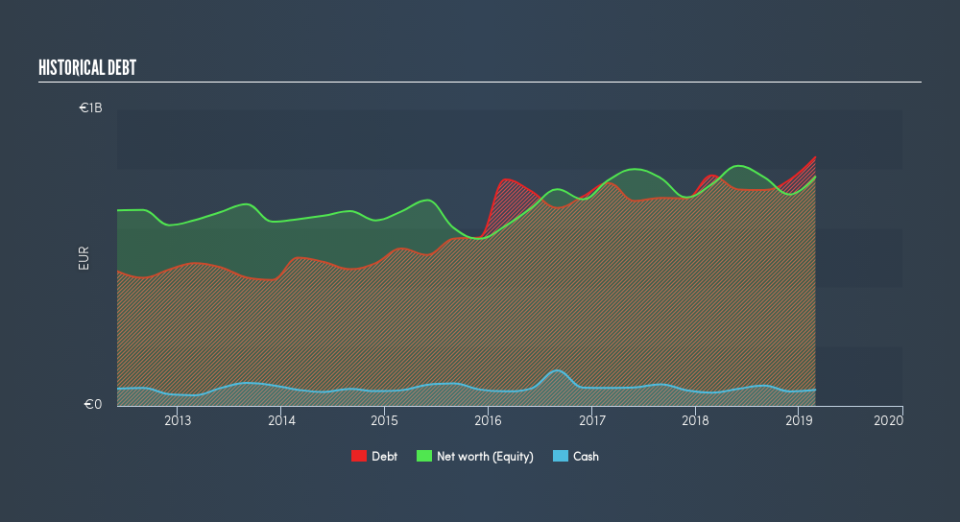Is Chr. Hansen Holding A/S's (CPH:CHR) Balance Sheet A Threat To Its Future?

There are a number of reasons that attract investors towards large-cap companies such as Chr. Hansen Holding A/S (CPH:CHR), with a market cap of ø85b. Risk-averse investors who are attracted to diversified streams of revenue and strong capital returns tend to seek out these large companies. But, its financial health remains the key to continued success. This article will examine Chr. Hansen Holding’s financial liquidity and debt levels to get an idea of whether the company can deal with cyclical downturns and maintain funds to accommodate strategic spending for future growth. Remember this is a very top-level look that focuses exclusively on financial health, so I recommend a deeper analysis into CHR here.
See our latest analysis for Chr. Hansen Holding
CHR’s Debt (And Cash Flows)
CHR has built up its total debt levels in the last twelve months, from €777m to €839m – this includes long-term debt. With this increase in debt, the current cash and short-term investment levels stands at €54m to keep the business going. On top of this, CHR has generated cash from operations of €313m during the same period of time, leading to an operating cash to total debt ratio of 37%, signalling that CHR’s debt is appropriately covered by operating cash.
Can CHR meet its short-term obligations with the cash in hand?
At the current liabilities level of €336m, the company has been able to meet these commitments with a current assets level of €429m, leading to a 1.28x current account ratio. The current ratio is calculated by dividing current assets by current liabilities. For Chemicals companies, this ratio is within a sensible range as there's enough of a cash buffer without holding too much capital in low return investments.
Can CHR service its debt comfortably?
Chr. Hansen Holding is a highly levered company given that total debt exceeds equity. This is common amongst large-cap companies because debt can often be a less expensive alternative to equity due to tax deductibility of interest payments. Accordingly, large companies often have lower cost of capital due to easily obtained financing, providing an advantage over smaller companies. No matter how high the company’s debt, if it can easily cover the interest payments, it’s considered to be efficient with its use of excess leverage. Preferably, earnings before interest and tax (EBIT) should be at least three times as large as net interest. For CHR, the ratio of 47x suggests that interest is comfortably covered. Large-cap investments like CHR are often believed to be a safe investment due to their ability to pump out ample earnings multiple times its interest payments.
Next Steps:
CHR’s high cash coverage means that, although its debt levels are high, the company is able to utilise its borrowings efficiently in order to generate cash flow. This may mean this is an optimal capital structure for the business, given that it is also meeting its short-term commitment. This is only a rough assessment of financial health, and I'm sure CHR has company-specific issues impacting its capital structure decisions. I suggest you continue to research Chr. Hansen Holding to get a more holistic view of the large-cap by looking at:
Future Outlook: What are well-informed industry analysts predicting for CHR’s future growth? Take a look at our free research report of analyst consensus for CHR’s outlook.
Valuation: What is CHR worth today? Is the stock undervalued, even when its growth outlook is factored into its intrinsic value? The intrinsic value infographic in our free research report helps visualize whether CHR is currently mispriced by the market.
Other High-Performing Stocks: Are there other stocks that provide better prospects with proven track records? Explore our free list of these great stocks here.
We aim to bring you long-term focused research analysis driven by fundamental data. Note that our analysis may not factor in the latest price-sensitive company announcements or qualitative material.
If you spot an error that warrants correction, please contact the editor at editorial-team@simplywallst.com. This article by Simply Wall St is general in nature. It does not constitute a recommendation to buy or sell any stock, and does not take account of your objectives, or your financial situation. Simply Wall St has no position in the stocks mentioned. Thank you for reading.

